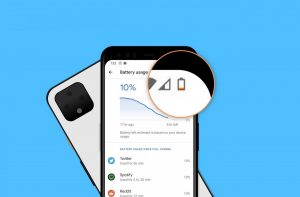Ever since I purchased the Pixel 4 XL back in October, I’ve been guarding it every chance I get. This year’s Pixel lineup has been met with a load of criticism and backlash, mainly concerning the phones’ poor battery life.
For me 4 XL is fun to use, but I also understand that these phones simply do not suit a lot of people’s preferences. Google will always have its small group of die-hard Pixel fans, but if the company wants to make its hardware more tempting to other buyers and not risk failing its existing customers to the growing competition, some things need to alter in 2020.
We’re still quite ways off from the Pixel 5, but when it’s undoubtedly released next October, these are the five main areas Google absolutely has to get right.
Click here to buy Google Pixel 4
Battery life
Without hesitation, the most significant criticism against Pixel 4 is its battery life. Particularly on the smaller Pixel 4 (and the 4 XL for some people), the battery just doesn’t run long enough for the phones to be practical options.
This is an area where Google struggled within 2018 with the Pixel 3 series, and the Pixel 4 was questionably even worse. Battery life is one of the most significant factors for any phone, so for Google to miss that goal two years in a row is pretty unfavorable. On a side note, do check out LinkLifting for making great backlinks.
What makes this so annoying is that this should be a relatively easy thing to resolve. Why does the Pixel 4 have such a hard time reaching to the end of a day on one charge? Perhaps because its battery is 2,800 mAh not to state that it has to power a 90Hz display.
A 2,800 mAh battery was not ever going to cut it.
So, how does Google improve this sphere with the Pixel 5? Use. A. Superior. Battery. That’s it, that’s all that desires to be done. May be a bit thicker phone with a decently-sized battery, and there you have it.
While I personally haven’t had any noteworthy complaints with the Pixel 4 XL’s battery life, people shouldn’t need to go with the larger, costlier version of a phone just to get satisfactory endurance. The small Pixel needs to improve in these respects, and if Google muddles this up again with the Pixel 5, it’s going to be tough to keep endorsing these phones to people.
Related: GOOGLE PIXEL 4: EVERYTHING WE KNOW
Ultra-wide camera
Amongst all the phones I’ve used in 2019, the Pixel 4 has been one of my preferences to take pictures with. It’s been exceptionally reliable, taking gorgeous-looking photos in just about any situation.
The Pixel 4 showed the first time Google added a second lens to its back camera, with all previous Pixels before it only having one back camera. The telephoto camera on the Pixel 4 does function splendidly well, and I agree that it’s seriously unappreciated. Though, that doesn’t make me miss the lack of an ultra-wide camera any less.
On this year’s Made by Google event, Google Research’s Marc Levoy said:
Although wide-angle can be fun, we think telephoto is more vital.
Marc Levoy – Google Research
Click here to buy Google Pixel 4 XL
No doubt, wide-angle is a lot of fun, but saying that telephoto is “more important” as a way to defend not putting a wide-angle camera on the Pixel 4 doesn’t cut it. Even though I love shooting with the Pixel 4, I know there have been cool photo chances I’ve missed only for the fact that it doesn’t have a wide-angle lens. This is an almost inexcusable omission for a flagship that was released in late-2019, so here’s to expecting Google gets off its photography presumption in 2020 and lets its users take pictures however they want.
Better storage options

Akin to battery life, storage is another critical factor of a phone that can taint the user experience if not appropriately controlled.
The Pixel 4 and 4 XL begin at $799 and $899, correspondingly, and while you’d assume lots of storage at those prices, those models merely come with 64GB. If you want to enhance to 128GB, the maximum amount of storage the phones support, you need to pay another $100.
This is a damaging setup, and I say that as somebody who has a 64GB Pixel 4 XL and has been going along just okay with it. There are a few things, in specific, I take issue with:
- 64GB shouldn’t be the base storage amount for a flagship phone. Apple’s responsible of this, and so is Google. That’s okay if you’re selling a mid-tier device, but for a tech giant, 64GB doesn’t cut it anymore
- Likewise, 128GB is too minor to be the highest amount of storage that’s provided. At the very least, 256GB should be a choice, and possibly even 512GB.
- All of this is made poorer by the fact that the Pixel 4 doesn’t support expandable storage and that infinite original quality Google Photos backups are not offered anymore.
Yet if you and I can get by just fine with 128GB or 64GB of space, other people can’t. If you’re downloading the audio for offline listening, loading the Pixel 4 up with videos for an impending road trip, and have a few games installed, that storage is going to be consumed through like nothing at all.
I don’t see Google proposing expandable storage anytime soon, so at the very slightest, the Pixel 5 needs to have a .more substantial beginning amount and broader options for people that want tons and tons of space.
Improved Motion Sense
One of the Pixel 4’s most exclusive, and debated, features is Motion Sense. When Google first teased that it was integrating its “Project Soli radar technology” into the phone, there was a lot of eagerness about the possibilities this could get to the Pixel 4. Instead, we got signs for skipping audios, snoozing alarms, and rejecting phone calls, that’s it.
I went liking Motion Sense a lot more than I had expected, but I also believe that the technology is harshly underused on the Pixel 4. The forehead on the Pixel 4 is a pretty bit bigger when matched against other phones to house its radar sensors, and I can’t accuse people that feel like Motion Sense doesn’t validate its impact on the Pixel 4’s design.
In its present state, Motion Sense doesn’t entirely justify its presence.
Skipping through audios by waving my hand over the Pixel 4 is fun, but that’s only I use it for. I wish I could use it to change my phone’s volume, navigate through web pages, etc., but it’s very restricted in its supported functions.
I don’t think Google would ditch Motion Sense on the Pixel 5, so supposing the technology sticks around for another year, I’d prefer for Google to unlock its full potential. If and when that materializes, Motion Sense could be a real reason to buy a Pixel over something else.
Price
Last, but most definitely not least, is the issue of price.
It is fine if Google wants to promote the Pixel as a flagship phone, but compared to the massive sea of competition, there’s no denying that it’s a difficult sell.
For instance, take the Pixel 4. At first look, it has an obsolete design, only two rear cameras, and an unreasonable $799 asking price. When you match that up against the $599 OnePlus 7T with an enticing design and more rear cameras, Samsung’s Galaxy S10 which is only $100 more, or even Google’s own $399 Pixel 3a, the value offer is hard to find.
There’s also the issue of Google almost instantaneously discounting the Pixel just a month after it’s publicized. This year witnessed the Pixel 4 getting a $200 price discount for Black Friday / Cyber Monday, with it still possible to buy it for $120 off.
If Google’s so eager to cut prices, why not just make those the MSRP? If Google had emerged with the Pixel 4 for only $599 at the unveiling, it would have been a lot more tempting than it ended up being.
A lower-than-usual retail price for the Pixel 5 could really change the situation we usually have about Google’s flagship, and all for the better. This appears like the thing most unlikely to happen compared to everything else stated above, but at some point in the coming future, Google needs to understand that its existing pricing strategy doesn’t work.










